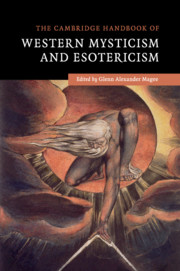Book contents
- Frontmatter
- Dedication
- Contents
- Acknowledgments
- Editor's Introduction
- List of contributors
- I ANTIQUITY
- II THE MIDDLE AGES
- III THE RENAISSANCE AND EARLY MODERNITY
- 12 Renaissance Hermetism
- 13 Christian Kabbalah
- 14 Paracelsianism
- 15 Rosicrucianism
- 16 Jacob Boehme and Christian Theosophy
- 17 Freemasonry
- 18 Swedenborg and Swedenborgianism
- 19 Mesmer and Animal Magnetism
- IV THE NINETEENTH CENTURY AND BEYOND
- V COMMON THREADS
- Suggestions for Further Reading
- Index
- References
18 - Swedenborg and Swedenborgianism
from III - THE RENAISSANCE AND EARLY MODERNITY
Published online by Cambridge University Press: 05 May 2016
- Frontmatter
- Dedication
- Contents
- Acknowledgments
- Editor's Introduction
- List of contributors
- I ANTIQUITY
- II THE MIDDLE AGES
- III THE RENAISSANCE AND EARLY MODERNITY
- 12 Renaissance Hermetism
- 13 Christian Kabbalah
- 14 Paracelsianism
- 15 Rosicrucianism
- 16 Jacob Boehme and Christian Theosophy
- 17 Freemasonry
- 18 Swedenborg and Swedenborgianism
- 19 Mesmer and Animal Magnetism
- IV THE NINETEENTH CENTURY AND BEYOND
- V COMMON THREADS
- Suggestions for Further Reading
- Index
- References
Summary
Introduction
Emanuel Swedenborg (1688–1772) is best known for his theological writings published between 1749 and 1771. The eight-volume Secrets of Heaven (1749–1756) was written in Latin and published anonymously in London. According to Swedenborg, this work contained the inner meaning or spiritual sense of Genesis and Exodus and reestablished the link between the spiritual and natural worlds, which he believed had been severely weakened by the decline of the Christian Church.
Revealing these secrets of heaven was Swedenborg's essential mission. He believed that the Lord's Word, now unsealed, permitted him to view, as an eyewitness in the spiritual world, the Last Judgment described in Revelation. He recorded these observations in works on The Last Judgment (1758 and 1763). In his final work, True Christianity (1771), he proclaimed the Second Coming of the Lord Jesus Christ. Swedenborg published a total of eighteen theological titles. Several were multivolume works. Heaven and Hell (1758) is perhaps the best known. In Marriage Love (1768), he dropped his anonymity for the first time. He signed it “Emanuel Swedenborg, A Swede” and did the same for the remaining three titles he published.
According to Swedenborg's testimony, his call required that he live simultaneously in the spiritual and natural worlds for the last twenty-seven years of his life – an astounding claim. What prepared him for this task, what might possibly lend credence to it, and what has been its impact? I will address each of these questions in turn.
Swedenborg's Background, Employment, and Philosophical Project
Swedenborg was born on January 29, 1688, in Stockholm. He was the son of Lutheran Bishop Jesper Swedberg (1653–1735) and his wife Sarah Behm Swedberg (1666–1696). His father had a long and illustrious but somewhat controversial career in the church. His mother, who came from a family of iron mine owners, died when he was eight years old. The family moved to Uppsala in 1692, where Swedenborg was raised and attended the university. He graduated in 1709 with a degree in philosophy. His passion, however, was mathesis and mechanics. In 1710, he left on a five-year student trip, exploring mathematics and astronomy in England, Holland, and France. He returned in 1715 and launched Sweden's first scientific journal, Daedalus Hyperboreus (published 1716–1718). During this period, he worked with Christopher Polhem (1661–1751), the noted Swedish inventor.
- Type
- Chapter
- Information
- The Cambridge Handbook of Western Mysticism and Esotericism , pp. 211 - 222Publisher: Cambridge University PressPrint publication year: 2016



